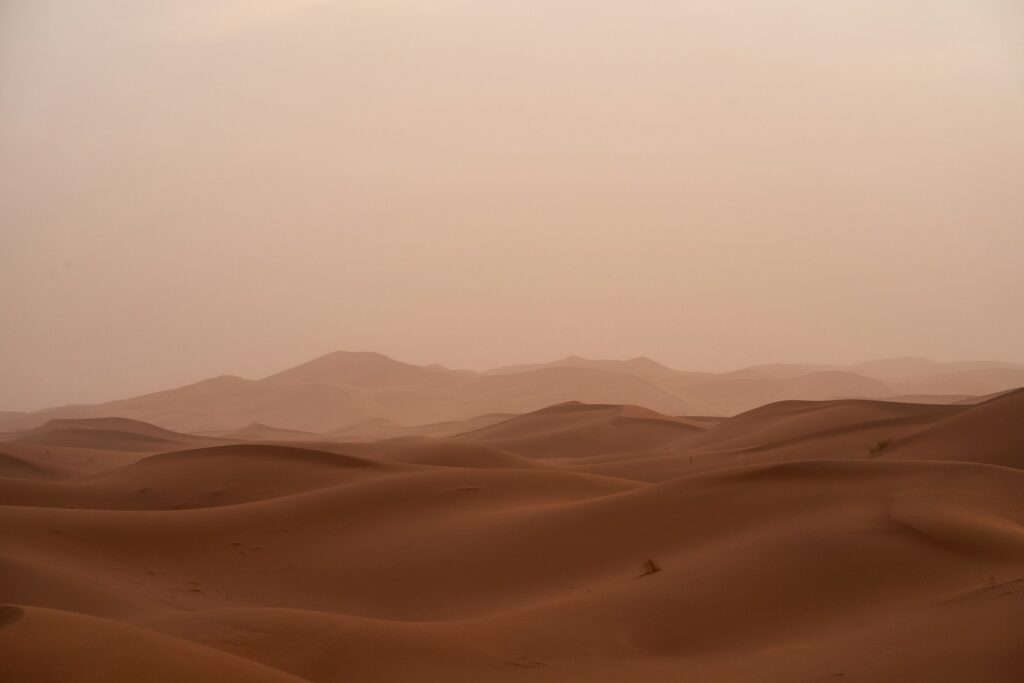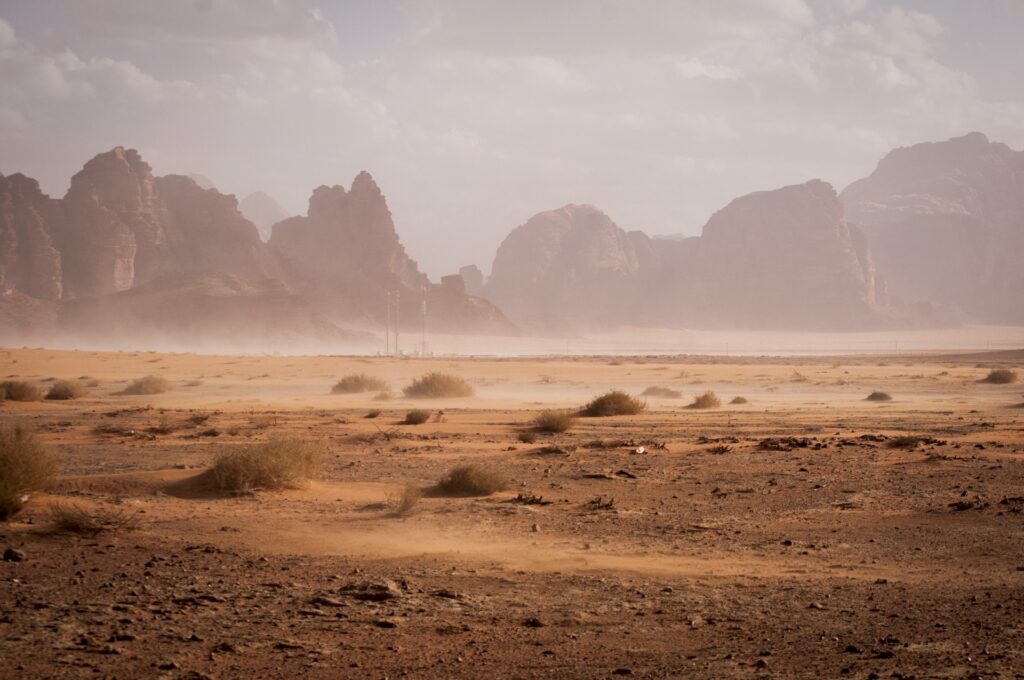The world’s deserts are awe-inspiring landscapes, sculpted by wind and time. But amidst the vast expanses of sand and towering rock formations lies a hidden power – the sandstorm. These walls of swirling sand can be both breathtaking and terrifying, a stark reminder of the raw energy that shapes these arid environments.
For anyone who has ever encountered a sandstorm, or even just witnessed one from afar, the questions arise: What exactly is a sandstorm? How long do they typically last? How often do they occur, and where are they most likely to form?
In today’s blog post we aim to answer all your questions to help you better understand these desert phenomena!
RELATED: All about the world’s deserts
What is a sandstorm?
Imagine a very strong wind whipping across a vast expanse of dry sand. As the wind picks up speed, it lifts loose particles of sand and dust into the air, creating a wall of swirling brown that can stretch for miles. This phenomenon – a sandstorm – is a powerful display of nature’s raw power.
Sandstorms, also known as dust storms, come in various intensities. Some are localised and short-lived, while others, known as haboobs, can be massive and engulf entire regions for days. The severity of a sandstorm depends on several factors, including wind speed, the amount of loose sand available, and the duration of the wind event.
How long do sandstorms last?
The duration of a sandstorm can vary greatly. A brief squall might only last for a few minutes, while a major haboob can rage for several days. The intensity of the storm also plays a role – a powerful sandstorm with high winds will likely last longer than a weaker one.
Here’s a breakdown of typical sandstorm durations:
- Short-lived squalls: These localised events can blow through an area in as little as 5-10 minutes.
- Moderate sandstorms: These storms may last for several hours, with winds strong enough to reduce visibility significantly.
- Major haboobs: These powerful sandstorms can rage for a full day or even several days. They can blanket entire regions in dust and reduce visibility to near zero.
How often do sandstorms occur?
The frequency of sandstorms depends on the specific desert region. Wadi Rum experiences sandstorms less frequently than some other deserts, but they can still occur.
Here’s a look at how sandstorm frequency varies:
- Frequent: Deserts like the Sahara can experience sandstorms several times a week, particularly during the spring and summer months.
- Occasional: Wadi Rum falls into this category, with sandstorms occurring a few times a year, primarily during spring and autumn.
- Rare: Some deserts, like the Atacama in South America, receive so little rain that they rarely experience sandstorms due to a lack of loose, windblown sand.
It’s important to note that these are just general trends. Weather patterns can be unpredictable, and even deserts known for infrequent sandstorms can experience occasional surprises.

Where do sandstorms occur?
Sandstorms are most common in arid regions around the world, particularly in these dusty hotspots:
- The Sahara Desert (North Africa): The undisputed king of sandstorms, the Sahara experiences frequent sandstorms, sometimes several times a week during spring and summer. Powerful winds whip across the vast sea of sand dunes, creating massive walls of dust that can engulf entire regions.
- The Arabian Peninsula: Home to the vast Rub’ al Khali desert, the Arabian Peninsula experiences frequent sandstorms, particularly in Saudi Arabia and the United Arab Emirates. These sandstorms can be particularly intense, reducing visibility to near zero and disrupting travel for days.
- The Gobi Desert (Asia): Spring is prime time for sandstorms in the Gobi Desert, as strong winds pick up loose sand and dust from this vast arid region spanning parts of China and Mongolia. These sandstorms can travel long distances, sometimes reaching as far as Korea and Japan.
- The Taklimakan Desert (China): Nicknamed the “Sea of Death” for its harsh conditions, the Taklimakan Desert in western China is another breeding ground for sandstorms. Due to its location deep inland and surrounded by mountain ranges, sandstorms here can be particularly intense and long-lasting.
- The Great Basin Desert (North America): While less frequent than in some other deserts, sandstorms can still occur in the Great Basin Desert, particularly in Death Valley, California. These sandstorms can be powerful and create localized dust storms that reduce visibility significantly.
This is just a sampling of the many deserts around the world where sandstorms are a natural phenomenon. Arid regions with loose sand, strong winds, and seasonal weather shifts are all prime ingredients for a brewing sandstorm.
Does Wadi Rum get sandstorms?
Yes, Wadi Rum does experience sandstorms, although they are less frequent compared to some other deserts. Sandstorms in Wadi Rum typically occur during the spring (March-May) and autumn (September-November) seasons when strong winds are more prevalent. These sandstorms are usually short-lived, lasting for a few hours at most.
Here at See Wadi Rum, we prioritise the safety and comfort of our guests. We closely monitor weather patterns and will always keep you informed of any potential sandstorm activity. In the unlikely event of a sandstorm during your visit, we have procedures in place to ensure your safety and well-being. This may include seeking shelter in our comfortable camps or rescheduling activities if necessary.
So, while sandstorms are a natural part of the desert experience in Wadi Rum, there’s no need to let them deter you from your adventure. By understanding these powerful phenomena and partnering with an experienced desert guide like See Wadi Rum, you can experience the wonders of Wadi Rum with confidence.
Ready to embark on your unforgettable desert adventure? Contact See Wadi Rum today and let us guide you through the captivating landscapes of Wadi Rum, sandstorms and all!
